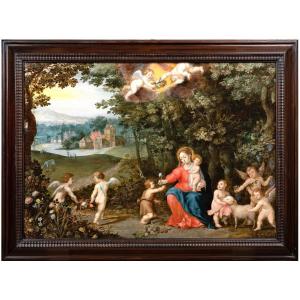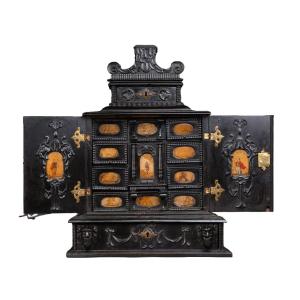Dimensions: h. 89 cm, l. 144 cm, p. 85 cm
By Etienne Doirat (1675-June 25, 1732), Regency period, 18th century
Although not stamped, our chest of drawers belongs by its shape and its bronze ornamentation to an identified corpus of the production of Etienne Doirat, one of the most talented cabinetmakers during the Regency. This group of chests of drawers listed in public and private collections, some of which are stamped E. Doirat, are characterized by the almost identical frontal cartouche. On our chest of drawers, this cartouche is formed by two festooned lambrequins joined by a clasp; they are extended by acanthus leafy and flowery branches with beaded friezes. Inside, two keyholes, the first with a lion's mouth, the second formed by two stylized dolphins facing each other with lion's paws under a lambrequin. Chests of drawers by Etienne Doirat with a frontal cartouche: Chests of drawers with an identical tomb shape: Chest of drawers stamped Doirat, Christie's London, July 10, 2008 lot no. 43 Unstamped chest of drawers, doc. Me Tajan, published in "French Furniture of the 18th Century" by Kjelleberg Chest of drawers of different shape, identical front cartouche: · Chest of drawers with three drawers, stamped Doirat, Christie's London, November 27, 2018 lot n 509 · Sarcophagus chest of drawers, stamped Doirat, J. Paul Getty museum, Los Angeles · Chest of drawers with two drawers, stamped Doirat, private collection, illustrated in J. - D. Augarde · Chest of drawers with three drawers, stamped Migeon, but attributed to Doirat from the former Eugène Kraemer collection, sale at the Georges Petit gallery (Paris), May 5-6, 1913, lot 141; former Ogden Mills collection, Paris, rue de Varenne; then by descent to his sister Béatrice, Countess of Granard; then by descent; Christie's sale, London, July 6, 2016, lot 51. Etienne Doirat was one of the few cabinetmakers of his time to affix his stamp, but only at the end of his career. In thirty years of activity, he produced a significant number of pieces if we judge the volume by his inventory after his death, but most of his works are not signed. These are primarily chests of drawers, which constitute the bulk of his production. The inventory drawn up on July 14, 1732, a few days after his death, mentions a large number of them, "en tombeau", "à la Régence", in "Esse", but also mentions large bookcases, wardrobes, sideboards, secretaires, regulators and various models of gaming tables, living room tables, bedside tables. These pieces of furniture are frequently dressed in amaranth or violet wood, veneered in leaves or inlaid with grids. Unlike his colleagues, he owned his stock of bronze models intended for his exclusive use, mentioned in his inventory as "imperfect lead models used as fittings for chests of drawers and other items." Doirat Etienne (1675-June 25, 1732) Descended from a family of artisans who had worked for at least a century in the Faubourg Saint-Antoine, he was born to a mason father around 1670 and obtained his master's letters in the early years of the 18th century. He worked all his life on Rue du Faubourg Saint-Antoine, or in its immediate surroundings, for a wealthy French and foreign clientele. His furniture, often sumptuous, belongs for the most part to the style in favor under the Regency.


















































 Le Magazine de PROANTIC
Le Magazine de PROANTIC TRÉSORS Magazine
TRÉSORS Magazine Rivista Artiquariato
Rivista Artiquariato